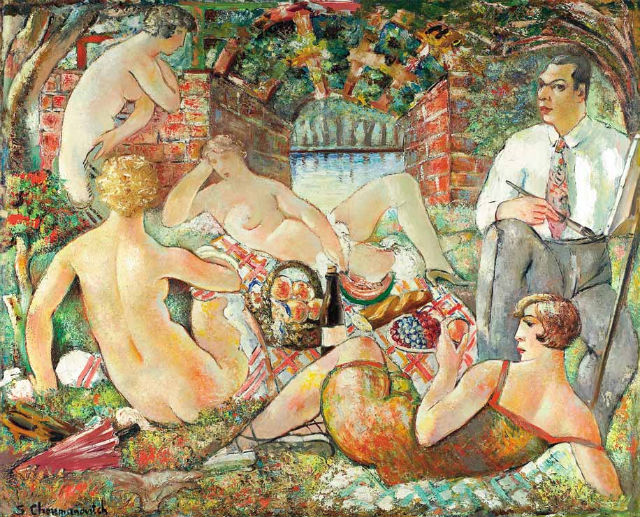Next door to the Gallery of Matica Serbia there is the fascinating Pavle Beljanski Memorial Collection of Art.
Who is Pavle Beljanski?
Pavle Beljanski was born in a sleepy town on the Danube River, Veliko Gradiste, in Serbia, in 1892, into a respectable middle-class family. After school he went to study law at Belgrade University, but WWI came along and he abandoned his studies to enrol into the Pupils’ Battalion in Skopje, winning several medals before he contracted TB and was invalided out of the army. Pavle then went to Paris to study law at the Sorbonne, and after the war to Stockholm to work as a clerk in the embassy of the new Kingdom of Serbs, Croats and Slovenes there.
This was the beginning of a very interesting diplomatic career and the beginning of his renowned art collection. He started buying in Berlin and Vienna when he was posted there, striking up friendships with young artists such as Marino Tartalja who were studying in Europe’s major cultural capitals, and when he returned to Belgrade in 1925 he kept up these friendships with young artists from his own country. He decided to collect the works of contemporary artists whose quality was recognised internationally, and create an anthology of his nation.
Between the two world wars Beljanski worked hard on expanding his collection and appointed the painter Jefto Peric to choose and buy pieces. He also promoted their work through exhibitions and writing reviews for numerous art magazines.
WWII disrupted his plans and his main worry was to keep his collection safe and out of reach of the Nazis. When the Germans formed a commission for the seizure of works of art in Belgrade, Beljanski was tipped off by a good friend who was a member of the commission. Beljasnki hid all his art in a box, and buried it in the coal cellar, keeping out any expensive frames which he displayed with mediocre paintings in them. When the commission come to value his collection they decided it wasn’t of a ny importance and left. He later said: “ Each of these painting is part of my life! Each of them went through my heart… “
This devotion to his collection saved his life during WWII. His family moved to Svilajnac in order to avoid the full atrocities of the German invasion of Belgrade but Beljanski decided to stay in the city and look after his paintings. Unfortunately Sviljanc was bombed on 24th September 1944 and the Beljanski family house was hit. Pavle Beljanski lost two sisters, a brother and their families. Beljanski was left on his own.
At the end of WWII the new country of Yugoslavia needed experienced diplomats and Pavle Beljanski was invited into the diplomatic corps again. As a skilful and knowledgeable diplomat he established relations with many countries and as a result was rewarded by different countries such as Poland, Ethiopia, Greece and Egypt. Beljasnki’s second spell in the diplomatic service lasted officially until 1958.
In October 1945 an exhibition of 67 paintings was arranged at the City Museum in Sombor. This exhibition was the first one in post-war Yugoslavia but also it was the first time Beljanski could see his collection in a gallery. The following year he arranged for several foreign diplomatic missions in Yugoslavia to visit the exhibition which despite being his private property, was thereby approved as ideologically sound by his communist masters. The same year ten paintings were chosen for a major retrospective exhibition of painting and sculpture of the people of Yugoslavia 19th and 20th centuries, which toured several Eastern European capitals.
Between 1952 and 1957 120 works from the Pavel Beljanski Collection were chosen for exhibition at the National Museum in Belgrade. Due to the size of the collection not all pieces could be shown at once, the exhibits were rotated to bring as many works to the public as practically possible. Pavle considers donating his art to a museum but under certain conditions, the main one being that part of it always had to be displayed, and displayed apart from other paintings in the museum. Only the museum in Vojvodina accepted his conditions and in 1957 he signed a contract with the Executive Council who built a gallery just for the Beljanski Collection.
The Pavle Beljanski Memorial Art Gallery contains paintings, sculptures, drawings and tapestries over two floors. One of the smaller parts of the Memorial is dedicated to Pavel Beljasnki’s life and you can see his diplomatic uniform, photographs of his parents, his medals and his first art collections. From a total of 185 works you can find 144 exhibited.
Entry is just £1. The Pavle Beljanski Memorial is open from Wednesday to Sunday from 1000-1800, Thursday 1300-2100 and closed on Monday and Tuesday. The list of paintings at the Pavle Beljanksi Memorial Collection you can find here.
If you are looking for a day trip to Novi Sad and the Pavle Beljanski Memorial with a private guide, driver and car please email tara@readyclickandgo.com












